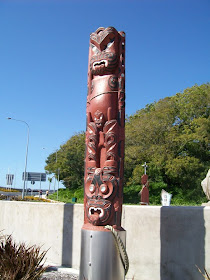Once rail reached Tauranga (and it took until 1925), it was a great route until passenger services finally ceased in 2001. Thankfully, freight still uses the lines.
Once the roads were fully formed and sealed, this took the place of rail as the main means to get people in and out of Tauranga. The Tauranga Harbour Bridge was opened in 1988, while the newer Tauranga Harbour Link was opened in 2009.
At the time of the road redesign for the new harbour link two years ago, a monument to even earlier means of transport to Tauranga was erected on land at the crossroads.
As traffic flowed around the completed Harbour Link project for the first time this morning, a ceremony was held acknowledging the history of the area. In the space where the roundabout at the bottom of the old bridge used to be, now lies a courtyard symbolising the history of Tauranga ... An anchor stone representing the anchorage of Tauranga Moana sits in the middle of the circular courtyard, surrounded by pouwhenua representing the waka of Takitimu, Tokomaru, Tainui, Mataatua, Te Arawa, Aotea and Kurahaupo ... The site is the original landing of the Takitimu canoe.
The anchor stone.
Takitimu. "Kaihautu Tamatea Arikinui stands atop the pou, and is accompanied by Ruawharo, the tohunga (spritual guide)." The carver was Damien Kohu. Local iwi Ngati Ranginui trace ancestry back to the Takitimu waka.
Mataatua. "Toroa, the kaihautu, guided Mataatua to a landing place in the eastern Bay of Plenty. The story is told of Wairaka, a young girl "acting like a man" -- Whakatane -- to stop the waka from being carried out to sea." Ngaiterangi trace descent from this waka. Carver: James Tapiata.
Above: Te Arawa. "With Tamatekapua as kaihautu, Te Arawa landed at Maketu. The tohunga, Ngatoroirangi, is associated with bringing volcanic fire to the central North Island." Te Arawa are centred around Rotorua. The carver was Robert Turner.
Above: Tainui. "The arrival of Hoturoa on the Tainui waka at the entrance to Te Awanui a Tamatea Arikinui (Tauranga harbour) is depicted on this pouwhenua. Hoturoa is shown sacrificing Wahinerua to gain access to the inner harbour ... Ballast from Tainui was thrown overboard at the shallowest part of the harbour to reduce the draught and allow the waka to proceed to the northern entrance. The pile of ballast stones can be seen today at Ratihi Rock, Mataka Island." Tainui descendants are today most readily identified with the Waikato district, although they also have had impact in neighbouring Auckland. The carver was James Tapiata.
Above: Aotea. "Turi, the kaihautu, is portrayed holding the toki (ceremonial adze) named 'Te Awhiorangi' (the encircler of heaven)." Descendants settled in South Taranaki, Whanganui and Ohakune. The carver was Guy Kakau.
Above: Kurahaupo. "This pou tells the story of two waka named Kurahaupo. The first, which arrived about 1150 AD, had Whatonga as kaihautu and Mahutonga as tohunga. This group eventually settled in Whanganui a Tara (Wellington), Porirua, Kapiti Island and Mana Island ... The second Kurahaupo came at the time of the great migration. The people settled in Waitara and North Taranaki." The carver was Simon Madgwick.
Finally, Tokomaru. "The pou represents Manaia, kaihautu of Tokomaru waka. Te Ati Awa of Northland and Taranaki trace their descent from those who came on this waka." Carver: Maurice Wharekawa.


















No comments:
Post a Comment